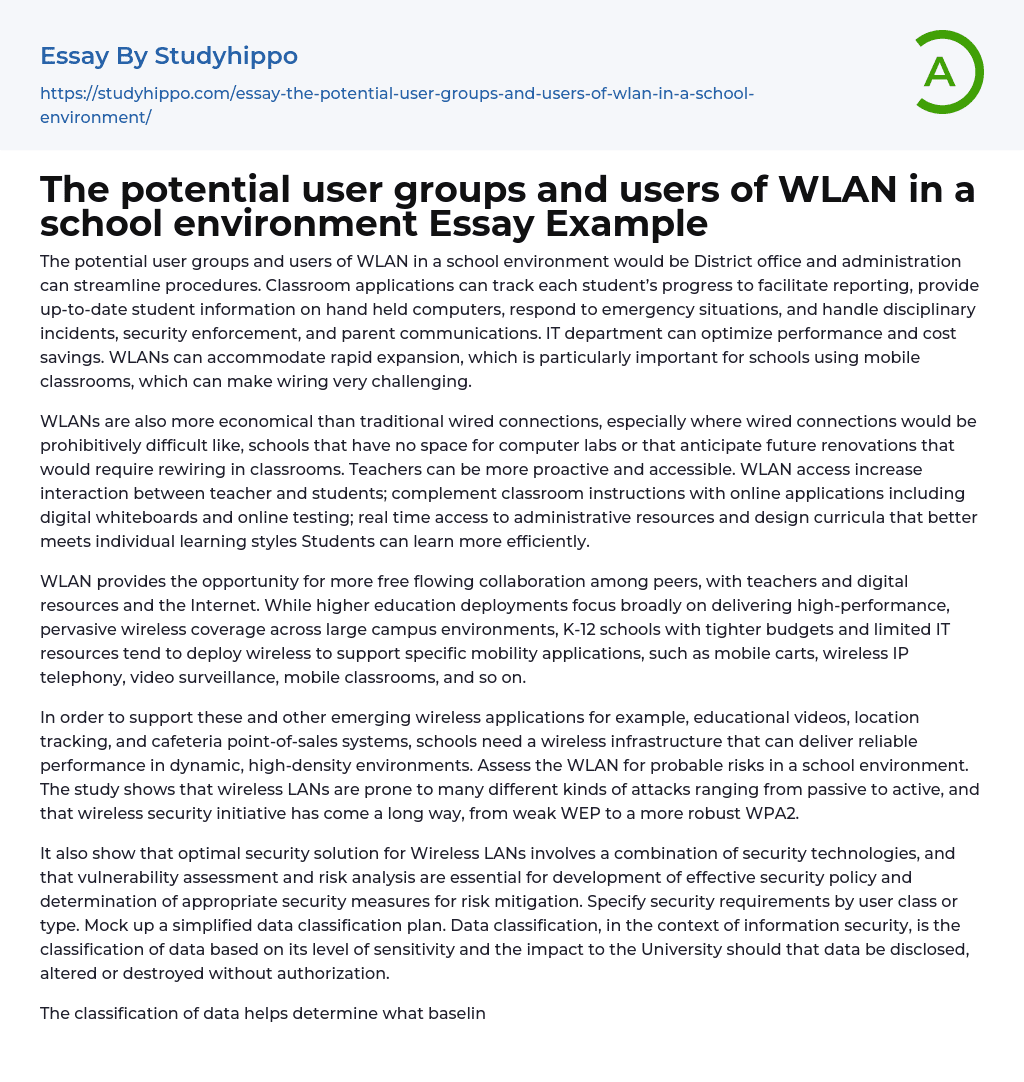

The potential user groups and users of WLAN in a school environment Essay Example
The potential user groups and users of WLAN in a school environment would be District office and administration can streamline procedures. Classroom applications can track each student’s progress to facilitate reporting, provide up-to-date student information on hand held computers, respond to emergency situations, and handle disciplinary incidents, security enforcement, and parent communications. IT department can optimize performance and cost savings. WLANs can accommodate rapid expansion, which is particularly important for schools using mobile classrooms, which can make wiring very challenging.
WLANs are also more economical than traditional wired connections, especially where wired connections would be prohibitively difficult like, schools that have no space for computer labs or that anticipate future renovations that would require rewiring in classrooms. Teachers can be more proactive and accessible. WLAN access increase interaction between teacher and students; complement classroom instructions wit
...h online applications including digital whiteboards and online testing; real time access to administrative resources and design curricula that better meets individual learning styles Students can learn more efficiently.
WLAN provides the opportunity for more free flowing collaboration among peers, with teachers and digital resources and the Internet. While higher education deployments focus broadly on delivering high-performance, pervasive wireless coverage across large campus environments, K-12 schools with tighter budgets and limited IT resources tend to deploy wireless to support specific mobility applications, such as mobile carts, wireless IP telephony, video surveillance, mobile classrooms, and so on.
In order to support these and other emerging wireless applications for example, educational videos, location tracking, and cafeteria point-of-sales systems, schools need a wireless infrastructure that can deliver reliable performance in dynamic, high-density environments. Assess the WLAN for probabl
risks in a school environment. The study shows that wireless LANs are prone to many different kinds of attacks ranging from passive to active, and that wireless security initiative has come a long way, from weak WEP to a more robust WPA2.
It also show that optimal security solution for Wireless LANs involves a combination of security technologies, and that vulnerability assessment and risk analysis are essential for development of effective security policy and determination of appropriate security measures for risk mitigation. Specify security requirements by user class or type. Mock up a simplified data classification plan. Data classification, in the context of information security, is the classification of data based on its level of sensitivity and the impact to the University should that data be disclosed, altered or destroyed without authorization.
The classification of data helps determine what baseline security controls are appropriate for safeguarding that data. All institutional data should be classified into one of three sensitivity levels, or classifications Restricted Data Data should be classified as Restricted when the unauthorized disclosure, alteration or destruction of that data could cause a significant level of risk to the University or its affiliates. Examples of Restricted data include data protected by state or federal privacy regulations and data protected by confidentiality agreements. The highest level of security controls should be applied to restricted data.
Private Data should be classified as Private when the unauthorized disclosure, alteration or destruction of that data could result in a moderate level of risk to the University or its affiliates. By default, all Institutional Data that is not explicitly classified as Restricted or Public data should be
treated as Private data. A reasonable level of security controls should be applied to Private data. Data should be classified as Public when the unauthorized disclosure, alteration or destruction of that data would results in little or no risk to the University and its affiliates.
- School Types essays
- Cloud Computing essays
- Computer Science essays
- Consumer Electronics essays
- Data Analysis essays
- Electronics essays
- engineering essays
- Enterprise Technology essays
- Hardware essays
- Impact of Technology essays
- Information Age essays
- Information Technology essays
- Modern Technology essays
- Operating Systems essays
- people search essays
- Robot essays
- Classroom essays
- College essays
- E-Learning essays
- Elementary School essays
- Examination essays
- Graduate School essays
- High School essays
- History Of Education essays
- Homeschooling essays
- Kindergarten essays
- Middle School essays
- Public School essays
- School essays
- Single Sex Schools essays
- Special Education essays
- Student essays
- Teacher essays
- University essays
- Vocational Education essays
- Wi-Fi essays
- Wireless Lan essays



